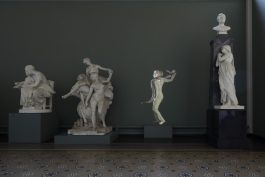The video work Salammbô takes its departure in Gustave Flaubert’s novel Salammbô from 1862 and was created in a dialogue with Jean- Antoine-Marie Idrac’s neoclassicist sculpture of the same name from 1903 (at the Ny Carlsberg Glyptotek, Copenhagen).
Flaubert’s novel presents a colourful, dramatic and erotic story, which unfolds in Carthage in the 3rd century BC. Salammbô is a young virgin, the daughter of the city’s ruler, who derives part of her strength from allowing a python to coil around her naked body. Over the years the novel’s inciting and erotic description has inspired many male artists, and the age-old motif of the naked woman and the snake is still alive in popular culture. In Western culture the snake is linked with something negative, cunning and dangerous, while in Ancient Egypt and the East it was ascribed qualities like wisdom and knowledge.
Eva Koch’s video installation presents a different picture of Salammbô. Here we see not a seductress imbued with a magical power, but a picture of female integrity. Eva Koch’s representation of Salammbô shows that the erotic body does not belong to the young alone but also to older women. Her Salammbô is wearing clothes; she is not stripped, subjected to staring male eyes, and she moves calmly and confidently, with great physical presence. Her calm and concentration are reinforced by the repetitive soundtrack made up of clicking fingers and hissing like a form of rhythmic white noise. Salammbô’s move ments are here the language of the body, just as precise and articulate as spoken language. Here dance is not a calculated seduction solely intended for male eyes, but the expression of a deeper sensuous approach to the body, to movement and to Eros.



